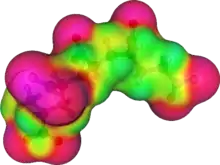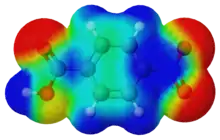COSMO solvation model
COSMO[1][2] is the abbreviation for "COnductor-like Screening MOdel", a calculation method for determining the electrostatic interaction of a molecule with a solvent. The method is commonly used in computational chemistry to model solvation effects.


COSMO treats each solvent as a continuum with a permittivity ε and therefore belongs to the "continuum solvation" group of models. As in all these models COSMO approximates the solvent by a dielectric continuum, surrounding the solute molecules outside of a molecular cavity. In most cases it is constructed as an assembly of atom-centered spheres with radii approximately 20% larger than the Van der Waals radius. For the actual calculation the cavity surface is approximated by segments, e.g., hexagons, pentagons, or triangles.
Unlike other continuum solvation models, COSMO derives the polarization charges of the continuum, caused by the polarity of the solute, from a scaled-conductor approximation. If the solvent were an ideal conductor the electric potential on the cavity surface must disappear. If the distribution of the electric charge in the molecule is known, e.g. from quantum chemistry, then it is possible to calculate the charge q* on the surface segments. For solvents with finite dielectric constant this charge q is lower by approximately a factor ƒ(ε):
The factor ƒ(ε) is approximately
where the value of x should be set to 0.5 for neutral molecules and to 0.0 for ions, see original derivation.[2] It must be noted that the value of x is erroneously set to 0 in the quite popular C-PCM reimplementation of COSMO in Gaussian.
From the thus determined solvent charges q and the known charge distribution of the molecule, the energy of the interaction between the solvent and the solute molecule can be calculated.
The COSMO method can be used for all methods in theoretical chemistry where the charge distribution of a molecule can be determined, for example semiempirical calculations, Hartree–Fock-method calculations or density functional theory (quantum physics) calculations.[1]
Variants and implementations
COSMO has been implemented in a number of quantum chemistry or semi-empirical codes such as ADF, GAMESS-US, Gaussian, MOPAC, NWChem, TURBOMOLE, and Q-Chem. A COSMO version of the polarizable continuum model PCM has also been developed. Depending on the implementation, the details of the cavity construction and the used radii, the segments representing the molecule surface and the x value for the dielectric scaling function ƒ(ε) may vary.
Comparison with other methods
While models based on the multipole expansion of the charge distribution of a molecule are limited to small, quasi-spherical or ellipsoidal molecules, the COSMO method has the advantage that it can be applied to large and irregularly formed molecular structures.
In contrast to the polarizable continuum model (PCM), which uses the exact dielectric boundary conditions, the COSMO method uses the approximative scaling function f(ε). Though the scaling is an approximation, it turned out to provide a more accurate description of the so-called outlying charge, reducing the corresponding error. A method comparison[3] of COSMO and the integral equation formalism PCM (IEFPCM), which combines the exact dielectric boundary conditions with a reduced outlying charge error, showed that the differences between the methods are small as compared to deviations to experimental solvation data. The errors introduced by treating a solvent as a continuum and thus neglecting effects like hydrogen bonding or reorientation are thus more relevant to reproduce experimental data than the details of the different continuum solvation methods.
See also
References
- A., Klamt; G., Schüürmann (1993). "COSMO: a new approach to dielectric screening in solvents with explicit expressions for the screening energy and its gradient". J. Chem. Soc. Perkin Trans.2. 2 (5): 799–805. doi:10.1039/P29930000799.
- Klamt, Andreas (2005). From Quantum Chemistry to Fluid Phase Thermodynamics and Drug Design. Boston, MA, USA: Elsevier. ISBN 9780444519948.
- Klamt, A.; Moya, C.; Palomar, J. (2015). "A Comprehensive Comparison of the IEFPCM and SS(V)PE Continuum Solvation Methods with the COSMO Approach". Journal of Chemical Theory and Computation. 11 (9): 4220–4225. doi:10.1021/acs.jctc.5b00601. PMID 26575917.